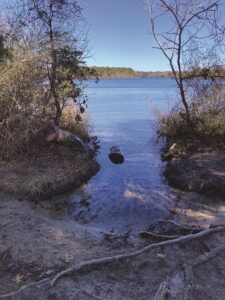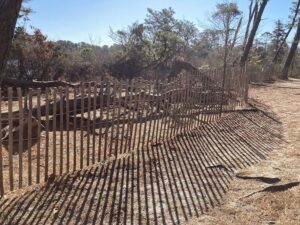EASTHAM — In the past couple of years, Wiley Park has seen an uptick of foot and paw traffic that has led to increased destruction of habitat and vegetation, according to conservation commission Chair Karen Strauss and open space committee Chair Frances Lewis.

Strauss’s committee and other town bodies are “going to be more proactive about addressing the damage and making sure it doesn’t get worse,” Strauss told the Independent. She plans to begin with two sessions in April to receive comments on how to balance conservation and recreation at the park, which could possibly progress to a public hearing in May on changes to the town’s conservation area land use regulations.
Those public sessions had not yet been scheduled when this edition went to press.
Strauss said that trails branching off official pathways and informal openings to the three ponds in the 44-acre conservation area were creating erosion into the ponds, and she cited “the increase in human activity and the number of dogs who are generally off leash” as the cause.
A herring run that comes under Herring Brook Road and into Bridge Pond “has also been disturbed by people launching kayaks, stand-up paddle boards, and dogs,” Strauss said.
Destruction of vegetation in one area near the main parking lot became so bad last summer that the town’s dept. of natural resources, conservation dept., conservation commission, open space committee, and forestry committee began a restoration effort. Newly planted bayberry and blueberry bushes and scrub oak trees are now encased in snow fencing with signs explaining that the area “was severely disturbed/damaged by both canine and human overuse.”
The damage to vegetation has continued, however, and the conservation commission is considering a leash requirement for dogs at Wiley Park, Strauss said.
Open space committee member Kait Logan said the risk involved in letting new trails form is that they will stop vegetation from growing, which will in turn exacerbate erosion.
“When an area gets trodden down from overuse, nothing can grow there,” said Logan. “Without vegetation, there won’t be anything to stop runoff from going into the lake and impacting water quality.”
Strauss said that Wiley Park is a priority habitat area designated by the Mass. Wildlife Natural Heritage and Endangered Species Program. Vernal pools in the park contain pickerel frogs and cherry shrimp, and the ponds house freshwater sponges and bryozoans, or moss animals, which Strauss said are becoming increasingly rare because of declining water quality.
Strauss said that the commission has also issued a formal request for proposals for land stewardship and management plans for five different conservation areas in Eastham.
“We want guidance on how we can best manage these properties,” said Strauss. “We are trying to balance all of the users of the park while maintaining the natural resources as best we can.”
A ‘Doggy Dog’ World
When it comes to leashing dogs, however, Eastham Dog Owners Association (EDOA) president Ed Daniels says that the conservation commission is barking up the wrong tree.
“There are dozens of people who walk their dogs off leash in the park over the course of a day and do so without incident,” said Daniels. “To say that all dogs have to be on leash at all times seems like an overreaction to us.

“If a happy, friendly dog goes running up a trail ahead of its owner, some people might see it as a happy, friendly dog running up the trail,” Daniels added. “Others might see it as something more ominous.”
But truly unfriendly incidents are few and far between, according to Daniels. After searching police reports from the last two years, the EDOA came up with 11 dog incidents in Wiley Park. Six of those were about lost or found dogs, said Daniels. Two were inquiries about the dog laws, two were calls about dogs being off leash, and two were arguments between the dogs’ owners about what the rules were. Only one was about a dog attack, Daniels said.
“There weren’t any injuries,” said Daniels, “so I’m not sure how that was an attack.”
Daniels expressed concern about further regulations. “We are afraid that the open space committee and conservation commission will change the way dogs and their owners use the property,” Daniels said.
“I’m not sure how much of this is trying to mitigate a problem and how much of it is trying to get dogs out of the park,” he said.
But Daniels added that the EDOA has a vested interest in keeping the property healthy and beautiful. “We want to make sure that we stay welcome and are good stewards of the property,” he said. “We will certainly go out of our way to minimize and mitigate the damage.”
The EDOA has already worked with the conservation commission and Conservation Agent Keith Johnson to fill in holes in the park that were created by dogs, Daniels said. He also said that the association has made an offer to Johnson to donate to further conservation efforts. “I just don’t want the dogs required to go on leash,” said Daniels.
“Wiley Park was donated to the town for both conservation and recreation purposes,” Daniels said. “The conservation commission has a tendency to minimize the recreation aspect of the park. We want to make sure that it is available for all of our citizens, especially the cohort that uses it most often, which are the dog owners.”
According to members of the conservation commission and open space committee, they are already working hard to provide that delicate balance between recreation and conservation.
“The reason why we will be holding listening sessions in April is to better understand the needs of the public,” said Strauss. “We want to find a way to protect the important natural resources at the site while still allowing the public to be able to use it.”
“We aren’t trying to be party poopers,” added Logan. “We just want people to know what we are trying to do here and for people to enjoy the area without causing further damage. It’s important to keep it the way it is or else people won’t be able to continue to enjoy it.”
